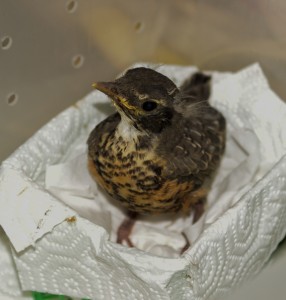American Robin—The Original Early Bird
Can you imagine a spring or summer without robins, singing their bright “cheerily, cheerio, cheerily, cheer up” song? Michigan State University (my alma mater—go Spartans!) faced this catastrophe in 1959. In the early 1950s, arbor specialists began trying to eradicate Dutch elm disease on campus by spraying the many elm trees with DDT. The insecticide manufacturer had assured them that the spray was not harmful to birds. But the oily residue stayed on the leaves; the leaves fell to the ground; the earthworms ate the leaves; the robins ate the earthworms. Within a week after each new wave of migrants arrived on campus in the spring, all of the robins were dead. By 1959, robins had been completely extirpated on the vast, bucolic campus. Faculty ornithologists eventually identified the culprit—as few as 11 earthworms delivered a lethal dose of poison to a robin—and stopped the use of DDT locally. This investigation was one of the cornerstones of Rachel Carson’s powerful and ground-breaking Silent Spring, which resulted in the banning of DDT as a pesticide throughout the U.S. And happily, the MSU robin population had returned to its pre-1950s level by 1979.
The American Robin is the largest species in the thrush family, which includes not only all bluebird species but also some of the most talented songsters in the avian world, such as Hermit Thrush, Wood Thrush, Swainson’s Thrush, and Veery. Adult males and females look quite a lot alike, although you can often differentiate them by the color of their heads: Males’ heads are much darker—almost black—while females’ heads are more gray with less contrast to their gray necks and backs. Juveniles are easy to identify—they have dark spots on their breasts and pale spotting on their upperparts. The only areas of Colorado that don’t have robins breeding are those without trees—croplands, grazing lands, or agricultural fields, for instance. You can see American Robins in Colorado all year long, although the birds are likely not the same birds. Banding studies suggest that we have one group of robins that breed here in spring and summer and a different group that winter here.
Saddled with the easily ridiculed scientific name of Turdus migratorius, its name derives from the Latin term for “wandering” (migratorius) and “thrush” (turdus). (Since most thrushes wander (migrate), it’s not really clear why the robin was singled out for this particular moniker.) Its common name arose from homesick European settlers in the U.S., who thought the birds looked like the English Robin, commonly found in Europe (but to which our robins are not closely related). Here’s a photo of an English Robin. Robins are a common sight at Greenwood: In addition to 44 juveniles and adults, we admitted 114 young robins in 2014.
Both parents take an active role in feeding nestlings. For the first few days after hatching, parents regurgitate soft invertebrates (e.g., grubs), parts of worms, and even some plant material (e.g., fruit) for the babies. After that, the parents just directly fill the gaping mouths with a variety of invertebrates and, occasionally, small fruit. Nestlings fledge about 13 days after hatching—well before they can fly much at all—and are fed by their parents for at least another 3 weeks. A robin’s fall and winter diet is 90% fruit; but in spring and summer, it flips to 90% invertebrates—especially earthworms. When a robin is hunting earthworms, it looks like it is listening for them, cocking its head to one side and then to the other before pouncing. But the noise that earthworms make is too faint to be heard above ambient sound. Robins are really using visual cues to detect the worms under the soil. Studies of captive robins indicate that they seem to prefer blue and red fruits (e.g., blueberries, strawberries) over yellow or green fruits (e.g., green grapes). Robins do not eat seeds at all; if they ingest seeds with fruit, either they regurgitate them or the seeds pass through their systems completely undigested. So we always have to impress on volunteers that to save some money for Greenwood, don’t give robins any bird seed! Also, robins love bathing in water. So as Greenwood’s young robins get bigger and move to larger cages, we try to give them a medium-sized shallow pan with fresh water whenever appropraite. Stand back and watch the droplets fly!
During breeding season, robins are the last to sing in the evening twilight after sunset. And they greet the morning long before most humans and other birds are up—often more than an hour before dawn’s early light. In fact, this characteristic gave rise to the adage “The early bird catches the worm.”

